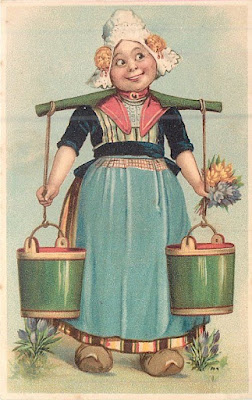‘On the eighth day of Christmas
My true love gave to me -
8 maids a’ milking!”
1884 trading card, The Old Design Shop
‘Eight maids a’milking’
Sounds pretty straightforward doesn’t it?
But in the 1760’s, seldom was there anything that didn’t have a double meaning, a hidden agenda.
And milk maids were no exception!
‘The Milkmaid’ by JohannesVermeer, 1657-58
Some viewed milk maids as ‘every woman’, or what we might call ‘Jane Doe’.
Unfortunately they were on the bottom of the pay scale and social status.
They served a master who considered them as worth very little and easily replaceable.
Most lived in the city!
Dreamstime Stock Photos
Milk was not a common drink, due to poor storage - no refrigerators! So milk spoiled rapidly and easily.
It was mostly used in custards, cheeses sour milk cooking and puddings.
All dishes that stored better than raw milk.
Nellie uploaded this to Pinterest
However there was a demand for fresh milk - for children and the elderly, and for the ‘frail’.
St. James Park in London was where you went for freshly milked milk.
David Soiron, 1780; V&A Museum, London
‘Rain, frost, or snow, or hot or cold,I travel up and down,
The cream and milk you buy of me
Is best in all the town.
For custards, puddings, or for tea,
There’s none like those you buy of me.’
1805 ‘Milk Below’
Later shortened to “Milko!”
A song milk maids sang to gather customers.
A Dutch vintage milkmaid, courtesy tuckdb.org
So where is that hidden meaning?
A maid or maiden refers to a single, unmarried woman.
“Let’s go a’milking”
meant either a proposal of marriage,
Or a proposal of another kind!
(We would call that a proposition)
If the response was negative
the potential suitor could laugh and say
‘Oh, well, I thought you might like to help with the cows!’
Dignity saved, laughter ensued.
Courtesy Boston Public Library
So, was our true love making sure we understood the proposal, repeating it 8 times?
Or was he concerned with our frail health?
Hard to say.
Let’s take a history break, and make something!
Here is a print & cut cow for you to put together. Could be cute on your desk!
Or add it to a plate of cookies for your neighbor -
Milk & cookies!
This is a vintage embroidery pattern.If you stitch it with all red thread
you have a nice piece of ‘redwork’.
Stitch on a square or round piece of fabric you have cut out 2 of them. After embroidering put right sides together and stitch all around the edge, BUT leave a small opening. Turn right sides out.
Tuck inside cotton, or some dried herbs, and you have a little pin cushion, or sachet.
Close the small opening with more stitches.
Fill her buckets with white pins for a charming look!
Here is a different design.
Uploaded on Pinterest by Brada Hargues
Uploaded on Pinterest by CatGirl007
Next are a couple of giggles for you:
By Kate Chidley
By Sandra Boynton
From Etsy
One more interesting milk maid story!
In the late 18th century many people died of diseases such as infections and smallpox. Things that today we don’t think about other than getting some antibiotics for infections.
They didn’t understand about germs and cleanliness and microbes and such.
There was a phrase
‘Smooth as a milkmaid’s skin’.
Smallpox, if it didn’t kill you, could leave you with terrible scars.
Except milkmaids didn’t seem to get the scars!
An Englishman, Dr. Edward Jenner, noticed.
He did some research.
Cows would get a disease called cow pox.
Milkmaids would get exposed to cow pox by milking infected udders.
Only cow pox was much milder and rarely caused death.
Milkmaids didn’t seem to get smallpox later.
Hmmmm.
Dr. Jenner decided to test his theory -
on a small 8 year old boy!
(Most children were not highly valued)
He took fluid from a cowpox sore
and injected it into the boy!
Nothing.
1 week later he exposed the boy to smallpox,
and he waited. And waited.
The boy didn’t get sick, and remained resistant to smallpox for the rest of his life.
Through this process, a cure for smallpox was eventually discovered.
So we can thank a milkmaid if we never get smallpox, don’t you think?
😁
‘Til next time,
inkspired
Some of the websites I visited to gather pictures and information, in no particular order or importance:
Unireadinghistory.org
RevKev43.Wordpress.com
Hampshirepewter.com
CarolyncHolland.Wordpress.com
JaneAustensworld.com
Wikipedia
Midphase.com
Pinterest
“A history of the cries of London” by T&J Bewick
“London Labour and the London poor” 1861-
Courtesy of Tufts Digital Library
















No comments:
Post a Comment